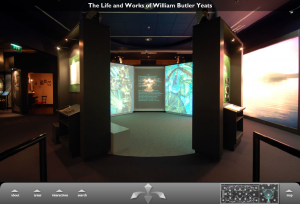by Julia Greider

In 2006, the National Library of Ireland, in Dublin, opened its award-winning exhibition entitled Yeats: The Life and Work of William Butler Yeats, which continues in 2018 to educate visitors about one of Ireland’s most acclaimed poets. As a city, Dublin is particularly proud of its literary heritage and displays it prominently, so this exhibition fits into the city’s broader mission when it comes to cultural heritage, particularly because Yeats wrote specifically about Irish culture and independence. The library now hosts an online version of the exhibition along with maintaining the physical exhibition and strives to make these exhibitions accessible to a wide range of people: the physical exhibit in Dublin is free to enter and likely to attract both Yeats enthusiasts and casual tourists, and the existence of the online exhibit ensures that people who can’t make it to Dublin are also able to experience the materials.
I had the opportunity to visit this exhibition in person in 2015. It’s located in a windowless room and dimly lit to create a mystical, intimate atmosphere that’s intensified by the numerous alcoves, decorated in a period-appropriate style, in which one finds more exhibit materials. The whole experience is overlaid with the recorded voice of Yeats himself reading a selection of poems. Part of the exhibit focuses on Yeats’s interest in magic and spiritualism, and the atmosphere of the exhibit space invites the visitor to imagine the ghosts of Yeats and his contemporaries around them. Having visited Dublin three years ago, the feeling of being in this exhibit space is still one of my most vivid memories of the city, even if I’ve forgotten many of the details of the materials themselves.
The online version of the exhibition is particularly unique in its use of a virtual space that is a direct photographic reproduction of the physical space at the National Library. Visitors navigate the rooms online using a map of the space along with a Google-Street-View-like interface. They can click on glass exhibit cases in order to see images and descriptions of the objects inside. In a way, this display allows viewers to get more up close and personal with the materials than the physical exhibit does, because they can zoom in on photographs and other archival materials. The online exhibit also provides a timeline of Yeats’s life that users can access at the bottom of the screen while viewing any of the glass cases. This feature helps the viewer put together the various scraps of Yeats’s life into a coherent and chronological narrative.
Although this is a very creative and effective format by which to translate a physical exhibit into an online one, there is of course still something lost in this translation. For example, the online version doesn’t allow visitors to zoom in on or even identify every object that they can see, which can be frustrating. However, this frustration could be fruitful—hopefully it motivates online visitors to make a pilgrimage to the physical exhibit in order to get the full experience. Additionally, the “Voice and Vision” area was one of the most powerful experiences of the physical exhibit for me, combining Yeats’s rhythmic and almost eerie reading voice with pastoral images passing across screens that enclose the area. This effect created the feeling that I was physically surrounded by and immersed in the poetry, which is impossible to reproduce in the online exhibit because the physicality of the situation is absent and Yeats’s voice is simply coming out of headphones or a computer speaker. Additionally, the online exhibit only plays one recorded poem, whereas the physical exhibit cycles through a number of poems, allowing for a more sustained experience.
The physical version of this exhibition is an impressive example of an effective use of atmosphere and decoration to enthrall visitors and keep their interest in the materials being exhibited. The online version extends the exhibition’s reach and communicates most of the historically significant features of the original exhibition while remaining grounded in the physical version, which likely encourages virtual visitors to visit in person as well. Thus, it accomplishes two goals of cultural heritage institutions at once: reach the broadest possible audience and attract new visitors seeking a deeper experience of history.
View the online exhibition at https://www.nli.ie/yeats/main.html
